Andy Reid Is Creating Football’s Future, and Patrick Mahomes Is Living It

This story appears in the FUTURE ISSUE, the Nov. 19–26, 2018, edition of Sports Illustrated.
What does the future hold for sports? Is it gene splicing? Positionless football? While no one can say for sure, this package presents a pragmatic look at the people and trends we expect to dominate the next era. For more great prognosticating and storytelling, subscribe to the magazine—and get up to 94% off the cover price. Click here for more.

For the entire 2017 season there was one play that Andy Reid’s Chiefs practiced every Friday. That’s the day for goal-line work, and the goal line is where this play was designed to shine, taking advantage of the defense’s confusion to carve out a window of open space in a compact area.
Before the snap, one receiver sprinted across the formation. Then he did it again. Then, comically, a third time. Each time he passed behind the quarterback, who was under center, the receiver faked as if he was taking a handoff—but this play was not intended for him. Instead, after the motion man’s third trip across the field, the QB would take the snap and dump off a little pass to a running back in the flat, in the opposite direction.
Coaches still joke that Tyreek Hill logged at least 10 miles on these motions alone. But for all the practice reps, Hill’s hard work never paid off. The Chiefs never ran the play in a game. It stayed on the call sheet, unused.
Flash forward to August 2018. Matt Nagy was standing on the opposite sideline. A Kansas City assistant of five years, and the coordinator who’d overseen all of Hill’s back-and-forth-and-back-agains, Nagy was now the Bears’ head coach, and as he faced off in the preseason against his old mentor, Reid, he saw an opportunity. Midway through the fourth quarter, on a third-and-three with his team up 24–13, Nagy dialed it up: Garrett Johnson, a Chicago rookie, streaked across the formation one, two, three times, and amid all the misdirection, quarterback Tyler Bray tossed the ball to fullback Michael Burton for a 10-yard gain.
Coaches on both sidelines fought back smirks. Nagy had done it: He’d finally called Lollipop.
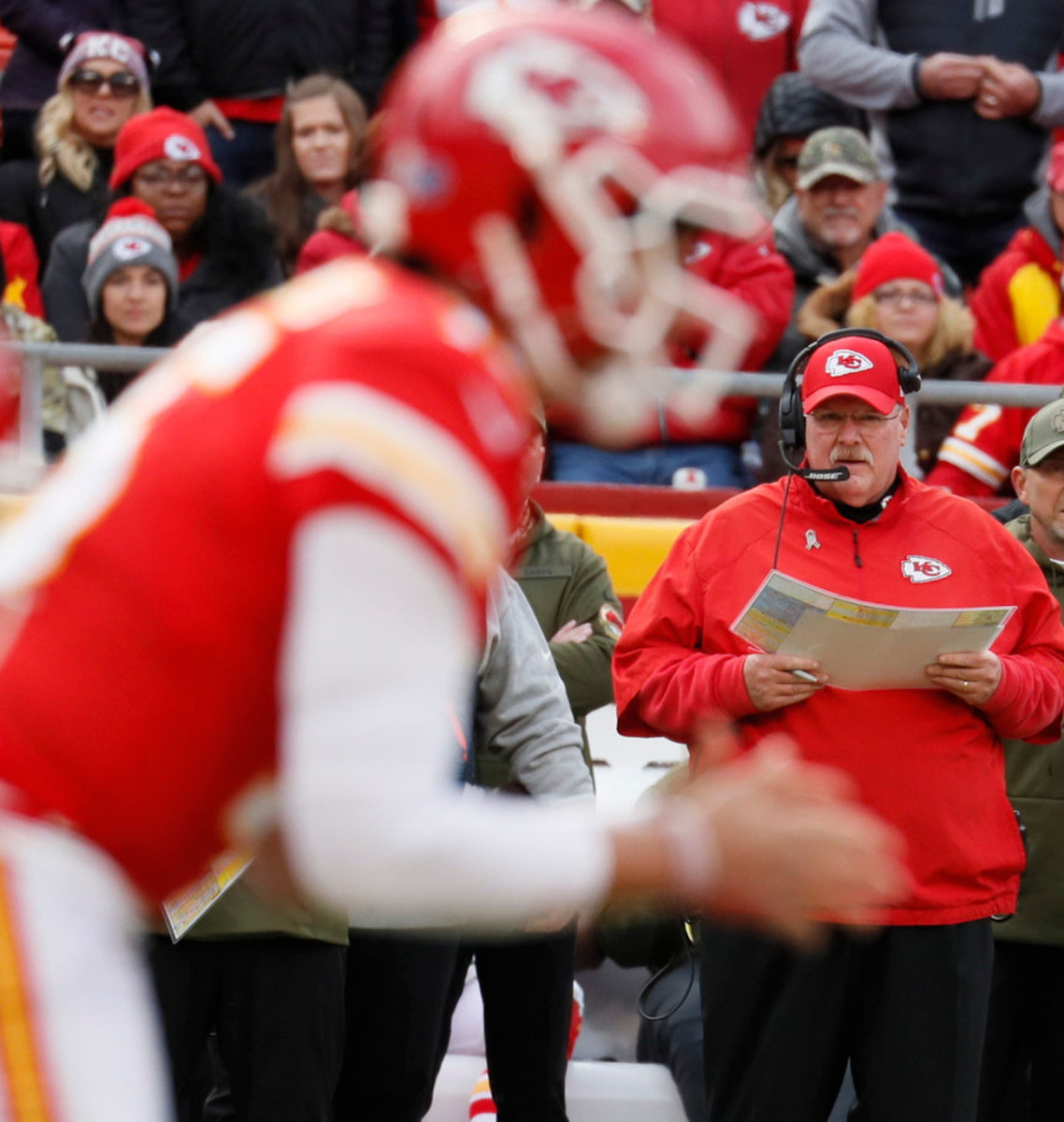
This was a single first down in a game that meant next to nothing, but Lollipop represented something bigger: Regardless of who actually called the play, here was Andy Reid reimagining how offense is played in the NFL. He was connecting the present to the future.
Really, it was a simple play, made confusing for the defense by a ridiculous presnap motion. And it had been lifted from the college ranks. (Specifically: the presnap chaos practiced in 2017 by LSU offensive coordinator Matt Canada.) Both the play’s name and the formation, Weezy Right, were a nod to Louisiana-born rapper Lil Wayne. The first time the Chiefs installed Lollipop, quality control coaches queued up that chart-topping 2008 Weezy track in the meeting room. The music might not have been Reid’s style, but, as is his way, he embraced it.
To watch Kansas City’s offense in 2018 is to participate in a sort of shell game, striving to keep track of movements as objects are deftly rearranged in front of you. Reid’s Chiefs send someone in presnap motion more often than they don’t. And through Week 8 they’d sent three or more players in motion 15 times, more than any other team in the league. Their two most dangerous pass catchers, Hill and tight end Travis Kelce, dart all over the formation, creating for quarterback Patrick Mahomes endless possibilities for where to go with the football.
This—is this where the present meets the future? It’s a time warp from three yards and a cloud of dust, but, shrugs Reid, “I don’t know if I’m on the forefront of anything.” The stats suggest he’s being coy. The 9–1 Chiefs are scoring at a clip—4.4 touchdowns per game—matched by only two other teams in the modern era, across 16 games: Peyton Manning’s 2013 Broncos and Tom Brady’s ’07 Patriots. By the midpoint of this season, Mahomes had tossed 26 TDs; only two other NFL QBs have ever topped 25 in the first half of a season, and we’ve already mentioned their hallowed names here.
So where did this all come from? NFL coaches tend to be late adopters of schematic trends—in part because pro talent levels are so even, unlike in college, where overmatched desperation spurs innovation; and in part because NFL coaching leashes are the shortest, which discourages risk-taking. But 13 years ago Reid saw the need to adapt—to bend his ways and borrow from others—in order to succeed. This was in February 2005, and Reid’s Eagles were playing the Patriots in Super Bowl XXXIX. Philadelphia spent the two weeks before that game preparing to pass-protect against New England’s 3–4 front—but then Bill Belichick’s team came out with four down linemen. Two defensive players plugged the A gaps all night and Reid’s QB, Donovan McNabb, taking almost all of his snaps under center, was something of a sitting duck. The Eagles, and a battered McNabb, lost 24–21. Now fast-forward to today: Mahomes takes 80% of his snaps out of the shotgun.
The West Coast system has been the foundation of Reid’s offense ever since he began his NFL coaching career as an assistant on Mike Holmgren’s Packers staff in the early 1990s. But as Reid transitioned later from McNabb to Michael Vick, the most talented dual-threat QB of his time, the coach recognized the possibilities of adding to that base the spread concepts he saw trickling up through the high school and college ranks—formations and motions that stretch the field horizontally, creating more permutations to befuddle a defense.
Reid had learned an important lesson about the power of space back in 1986, when he was the O-line coach at Northern Arizona under coordinator Brad Childress. The Lumberjacks’ freshman QB back then, Greg Wyatt, was struggling against the blitz, so NAU moved to a spread look, reasoning that if the defense had to cover five players across the field, some heat would be lifted off the QB. And that it did. The Lumberjacks went 7–4, their first winning season in seven years, and when Wyatt finished the year with I-AA freshman records for attempts and completions, it cemented another lesson: Do what works for your QB.
Reid’s vision, though, didn’t really blossom until he came to Kansas City in 2013. Back in Philly he had control of the Eagles’ personnel, but he didn’t want that burden with the Chiefs; he preferred to spend his time ironing out every nuance of the offense rather than searching for a player to replace someone who’d gotten injured on Sunday. And so down the hill from Arrowhead Stadium he set up an R&D unit for offensive football, scouring film and tinkering with new play designs. He hired Childress as a spread-game analyst (Childress would sort the Pro Football Focus database for every NFL play run out of an empty formation, looking for anything worth pilfering) and Chris Ault, the former Nevada coach, to coach K.C. in the pistol offense he popularized with Colin Kaepernick, replete with options and misdirections.
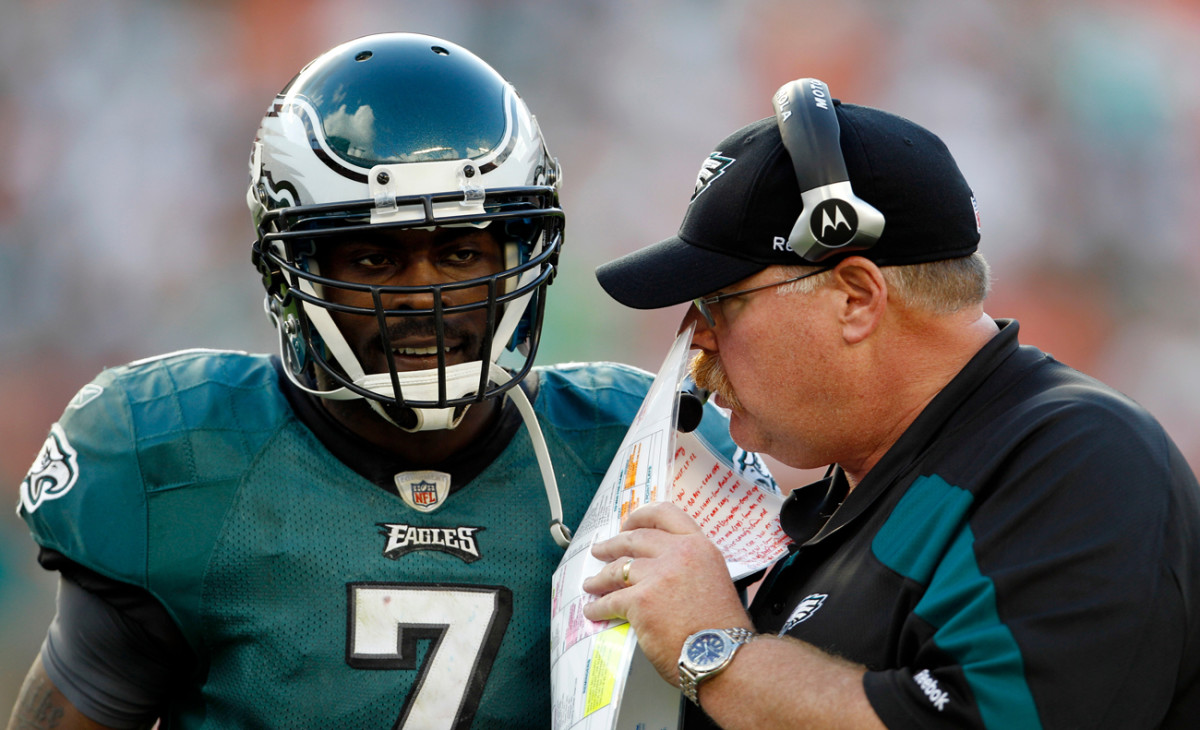
Reid would later tell his successor in Philadelphia, Chip Kelly (now at UCLA), that Kelly was the one who opened up the NFL’s offensive imagination—but, concurrently, that’s exactly what Reid and his staff were doing in Kansas City. A month after Reid joined the Chiefs, he traded for 49ers quarterback Alex Smith; then he dug back into Smith’s college tape from Utah, where Smith ran Urban Meyer’s spread-option offense before Tim Tebow ever did, including the zone-read plays that would be the precursor to run-pass options (or RPOs). Nagy remembers walking into Reid’s office on Monday mornings and watching the whiteboard fill up with ideas, inspiring the nickname “A Beautiful Mind.”
Then, on opening night in 2017, Reid’s Chiefs roughed up the defending Super Bowl–champion Patriots with an offense that looked like nothing the league had ever seen.
If you want the latest episode of The Monday Morning NFL Podcast in your feed when you wake up Monday morning, then subscribe to The MMQB Podcasts. (For non-subscribers, there is typically a lag.)
Kareem Hunt scurried up the right hash marks en route to a 78-yard touchdown catch, and NFL defenses still haven’t quite caught up. This was the play that flipped that game against New England two Septembers ago, when Kansas City scored the most points (42) and gained the most yards (537) ever against a Bill Belichick–coached team. The Chiefs had flooded the short (right) side of the field with four players. Tyreek Hill ran from left to right on a fly-sweep motion, pulling down the deep defender, and three other Chiefs sprinted downfield on vertical routes: Travis Kelce went on the diagonal, and receiver Albert Wilson sprinted up the sideline while Hunt arced out of the backfield. That left Patriots defensive end Cassius Marsh to try in vain to peel off the line of scrimmage and chase Hunt up the seam. In the end, it all worked exactly as the Chiefs staff had seen it play out before . . . on North Dakota State’s film.
Kansas City wasn’t planning on drafting a QB in 2016, but Reid and his offensive staff always study and grade the top prospects at that position each year anyway. That’s when they saw a young quarterback named Carson Wentz hit this play again and again for big gains against the likes of Illinois State and Weber State. Yup, Reid says unapologetically, “we were studying Carson and kind of snuck that one [from them].” (The Bison called this play He-Man because the H‑back worked into the seam up the field; the Chiefs call it All-Go Special Halfback Seam.)
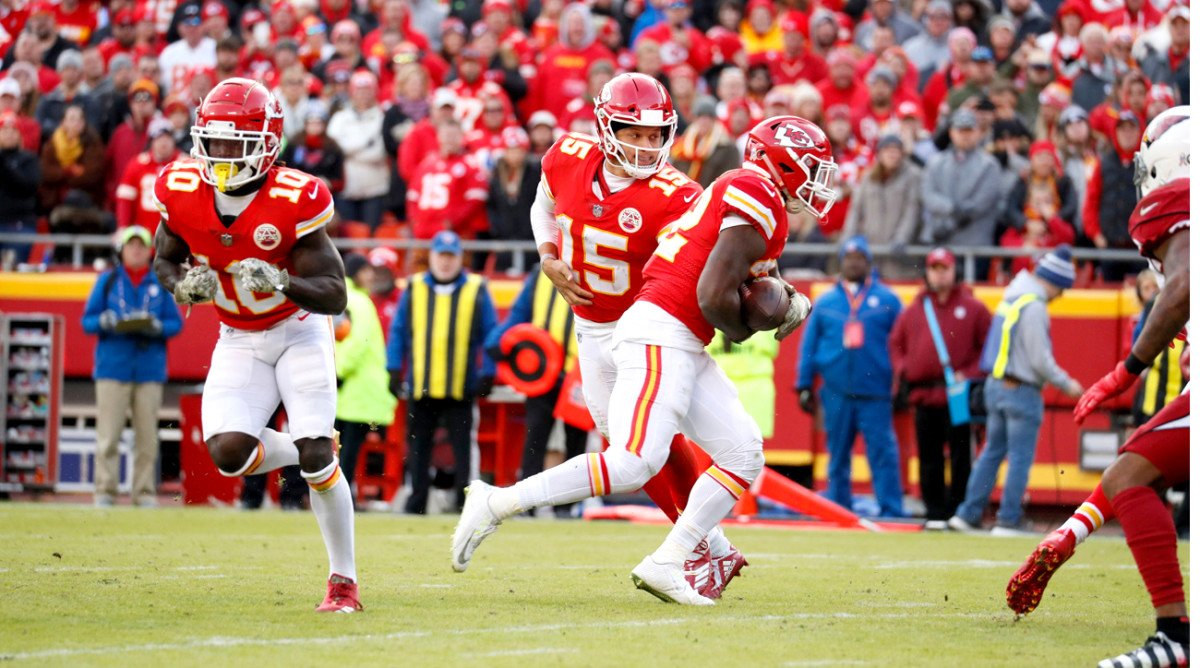
Such is the football circle of life: The Patriots used a variation of this play the following week for a 24-yard completion to James White in a win against the Saints. As did the Rams, a few weeks later, on a 53-yard Todd Gurley TD against the Cowboys. And when Drew Brees broke the NFL’s all-time passing yards record in Week 5 this season with a 62-yard touchdown, he did it on a similar concept: A player moves horizontally to draw down the secondary, while three vertical routes develop downfield.
It’s not just coaches like Nagy, Belichick, Sean McVay (in L.A.) and Sean Payton (New Orleans) who check the Chiefs’ film each week to see what Reid is up to. When a reporter prefaced a question in the lead-up to the Nov. 4 Browns-Chiefs game by guessing that Baker Mayfield hadn’t found much time to watch K.C.’s offense on film, the Cleveland QB jumped in: “Oh, I have been able to,” he said. “It’s a thing of art.”
As a young assistant in Green Bay, Reid would often bring new ideas to his fellow coaches. Alas, they were loyal to the gospel of the West Coast offense, a rhythm-based passing system in which a QB takes snaps under center and works through progressions. (Reid once persuaded Holmgren to let Brett Favre try the shotgun, but that experiment ended after one snap went flying over Favre’s head in a Saturday walk-through). When Reid pushed a new idea, “Holmgren’s pat answer, and [then Packers assistant] Jon Gruden’s pat answer,” reports Childress, “was, ‘Yeah, that looks like a good play—but you know what? I don’t know that play. When you get your own offense, you go ahead and feel free to put that in.’ ” But, Childress says, “that’s not Andy.”
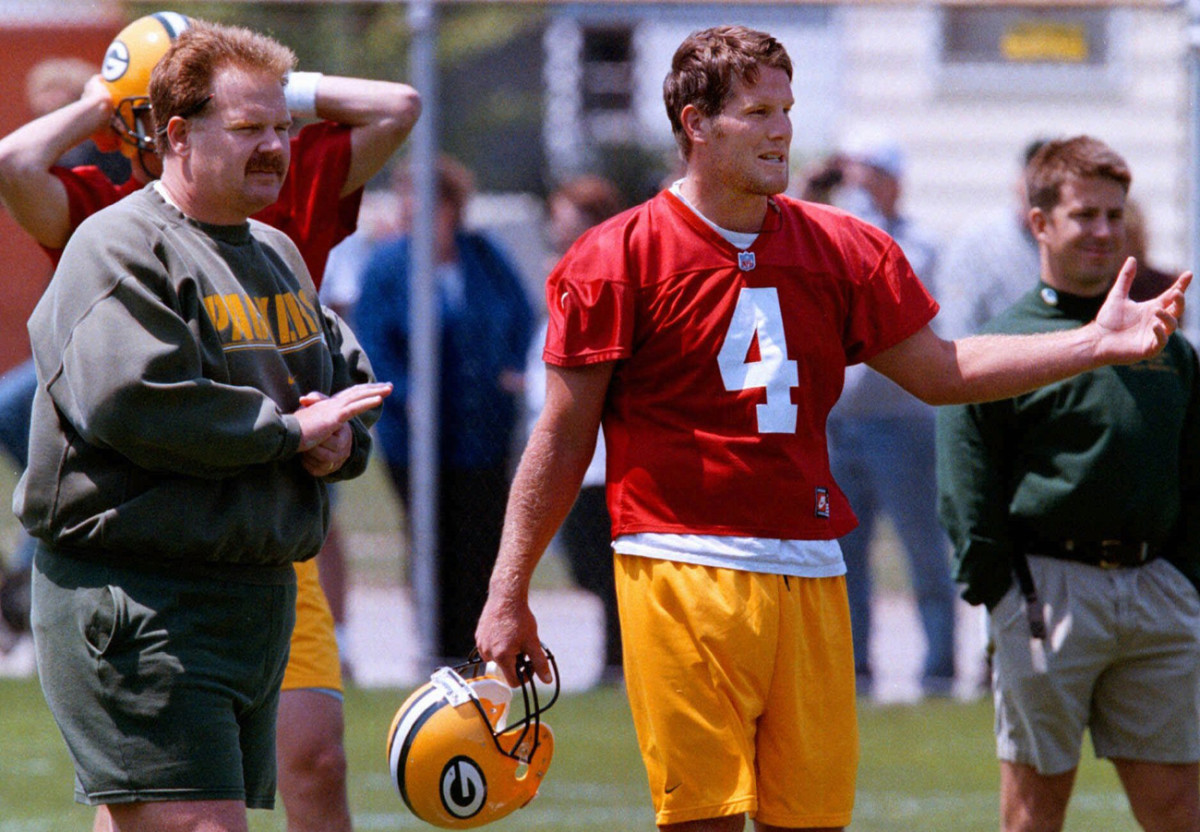
Today a big part of the job for K.C. quarterbacks coach Mike Kafka and for passing-game analyst Joe Bleymaier is to scour the college ranks for plays their coach might consider. And Reid doesn’t care who or where these plays come from. The offensive principle to which he is most loyal is simple: He’ll do anything for a first down.
The 2016 Chiefs traveled in November to play the Panthers in Charlotte, and after checking into their hotel on Saturday afternoon, several coaches caught a glimpse of a game between unranked Pitt and No. 3 Clemson. As they watched, it was more than just the unfolding upset that caught their eyes—they were sucked in by the misdirection tactics discombobulating Clemson’s defense. That was the first time they noticed Canada, who back then was Pitt’s OC.
“The plays in our playbook could be from any year, anywhere,” says receiver Chris Conley. “They just seamlessly come together. There’s this conglomeration of good plays [Reid] has accumulated over time. That’s what makes up this offense.”
It’s not far-fetched to say that Reid has spent much of the last decade preparing for Mahomes’s arrival. The marriage of QB and coach is such a perfect union, bubbling in offensive fertility, that Washington State coach Mike Leach, himself well-versed in the art of scoring points, muses, “There’s times you wonder if [their pairing] should even be legal.”
For Reid, 2018 is just the next step in a progression he’s been working at for some time now. “We looked at some of the college stuff, we got it growing and incorporated it into what we do,” he says plainly, modestly. “And then Patrick came in, and you just keep growing.”
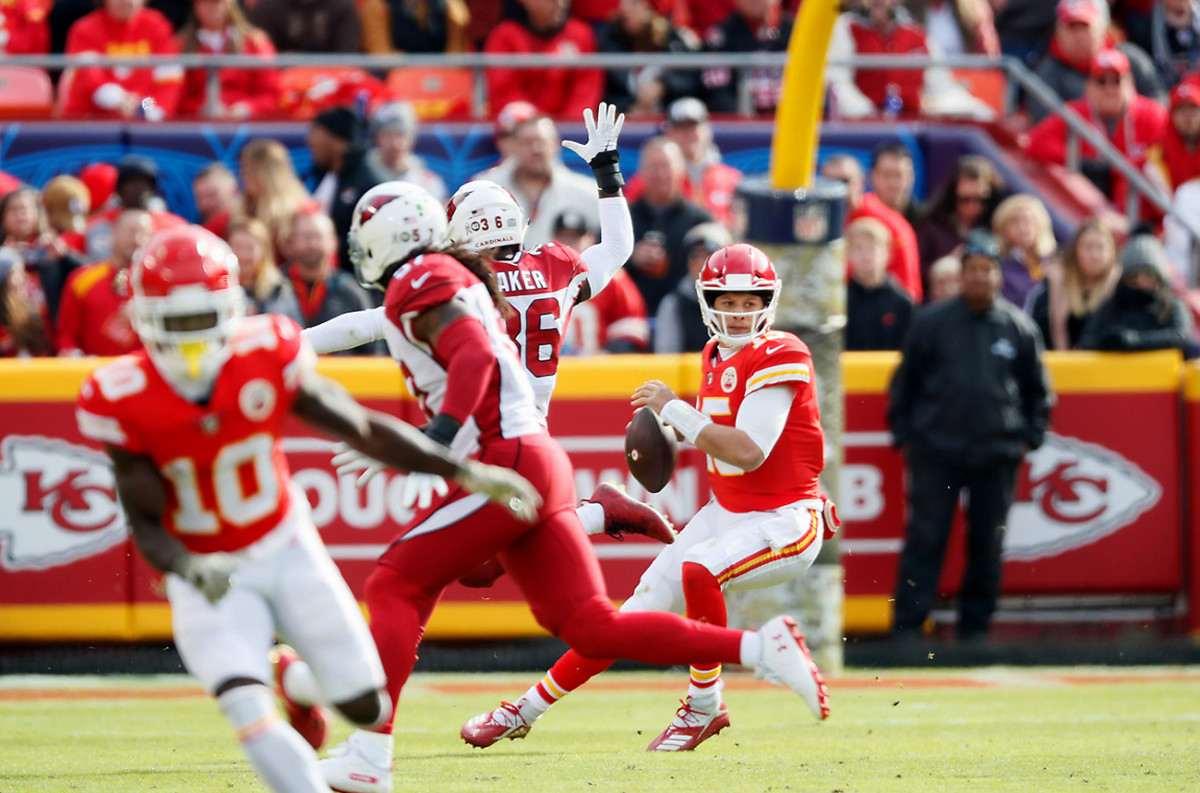
Even that’s an oversimplification. For years NFL coaches have groused about the glaring holes that exist in the games of players coming from college spread offenses. But, especially when it comes to QBs, Reid’s perception was different. He focused on what Mahomes gained from throwing the ball 1,349 times in Texas Tech’s Air Raid system rather than on the fact that the QB rarely took snaps under center. Coaches could teach him that. And while much of what the Chiefs run today was already in place before they drafted Mahomes at No. 10 in 2017—QB and coach have shared a few laughs over the fact that some people think they’re running a straight Texas Tech Air Raid—Mahomes does say he got Reid to install two of his favorite college plays: one concept K.C. has run a few times to Kelce, and another that Reid has yet to unveil.
As the Chiefs have continued to build their offense around principles familiar to their players from the college ranks, it has been easier to put them in positions to thrive. Hill is a perfect jet-sweep runner. Hunt can zip down the field on the seam route. Kelce and Hill are among the most moved-around players in the league at their respective positions, lining up tight, out wide, in the slot and in the backfield. Collectively these tasks are the underpinnings of the spread systems these chess-piece players learned at Oklahoma State (Hill), Toledo (Hunt) and Cincinnati (Kelce).
“It’s a neat transition we are in right now with these offenses,” says Nagy, who today is teaching his own young quarterback, Mitchell Trubisky, the system he had a hand in developing with Reid. “Everything comes full circle—and before you know it, down the road, I’m sure teams will be running the wishbone again.”
Perhaps it’s not so surprising that Reid—at 60 the NFL’s fourth-oldest coach—is at the front of the current offensive revolution when you consider it this way: What we’re seeing on the field today is the product of many different eras. The Chiefs’ playbook even includes one scheme from a 1970s veer offense. It’s a pitch trap, a bit of a tricky concept in which the quarterback fakes a pitch to the back on one side while a guard pulls to execute a trap block in that direction. Everyone flows one way, but then the QB whirls around to face the opposite direction and gives the ball to the other back on an inside handoff. Reid learned that one at John Marshall High in Los Angeles, where he played on the offensive line. His fellow Chiefs coaches laughed when he first installed the play, but Reid always knows when to call it, and they say it always works.
“I said this at the beginning of the year and people looked at me askew,” says K.C.’s right tackle, Mitchell Schwartz, “but a lot of what we do, the roots are in the ’60s and ’70s and ’80s. The game was more constricted back then, so you had to find ways to create good matchups. Now you add the space to it, and. . . .”
Schwartz trails off here, but we’ll finish his sentence for him: And you get what we’re seeing on the field now—the future of NFL offenses.
Question or comment? Email us at talkback@themmqb.com.
